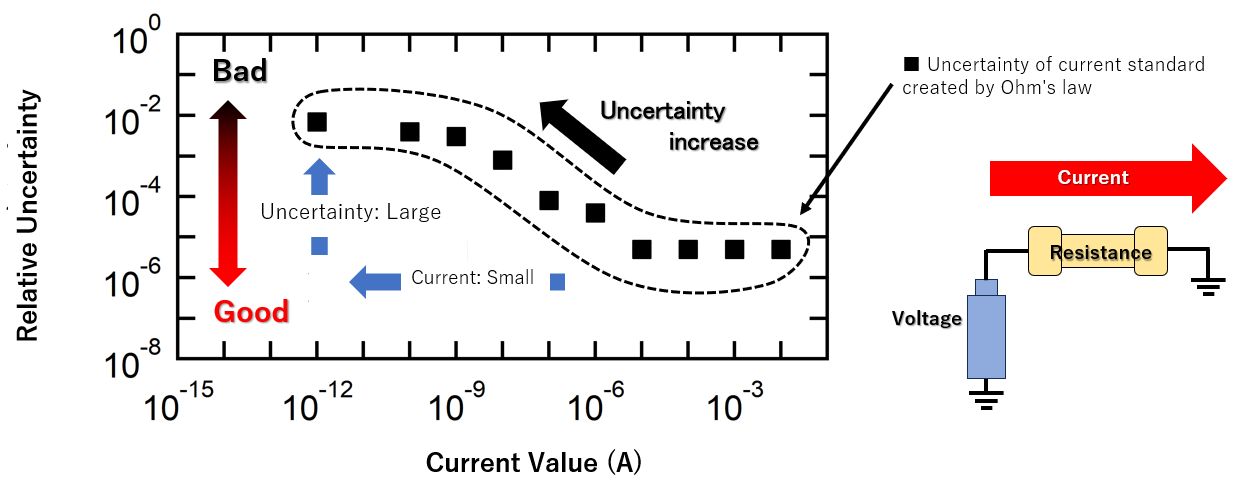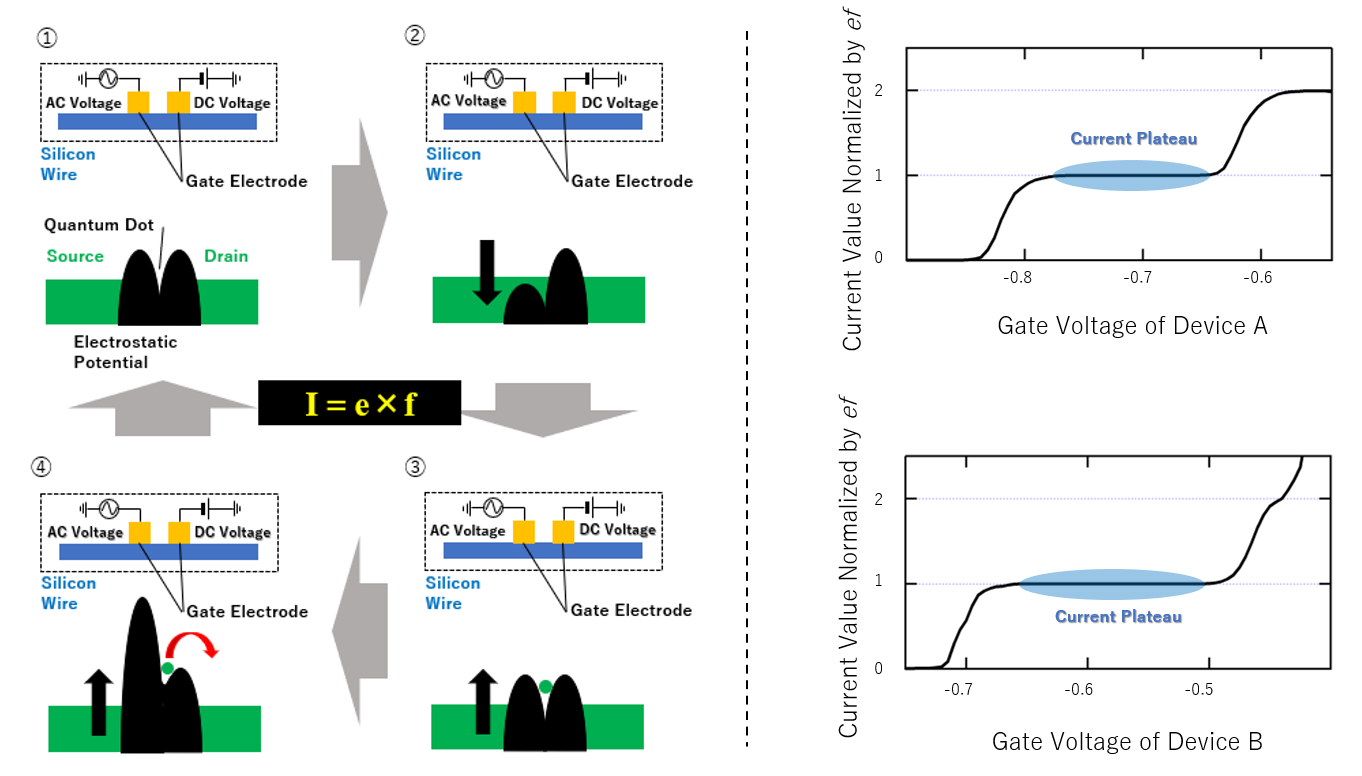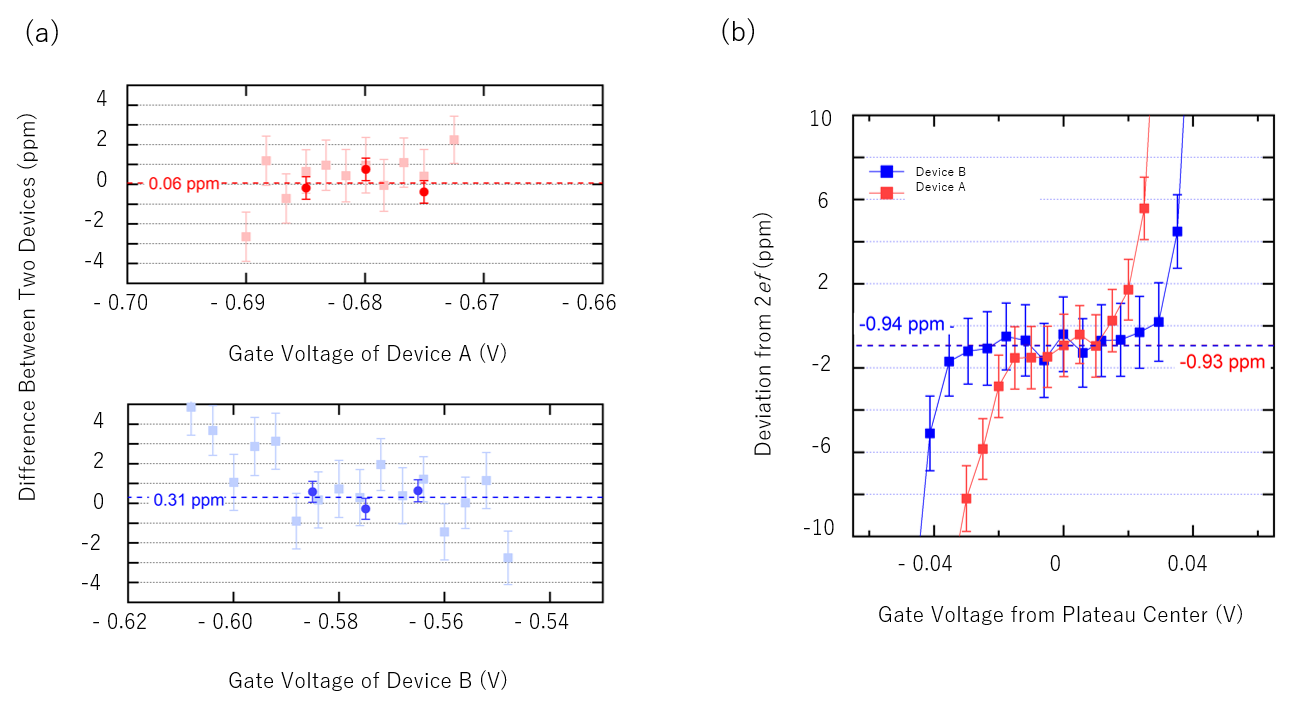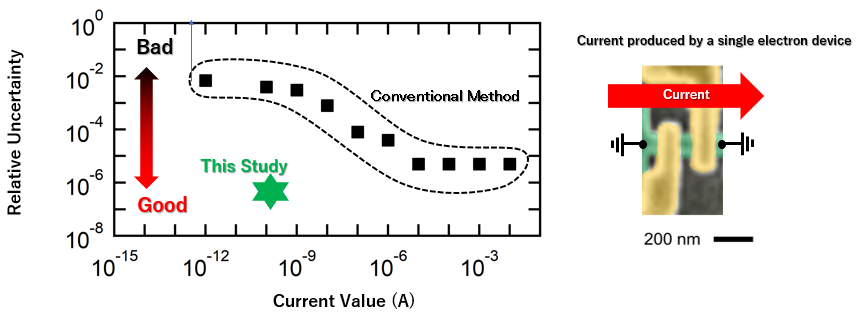Microsoft ends support for Internet Explorer on June 16, 2022.
We recommend using one of the browsers listed below.
- Microsoft Edge(Latest version)
- Mozilla Firefox(Latest version)
- Google Chrome(Latest version)
- Apple Safari(Latest version)
Please contact your browser provider for download and installation instructions.
December 20, 2023
National Institute of Advanced Industrial Science and Technology
NTT Corporation
Developing technology to compare and control small electric current generated by multiple silicon quantum dot devices with the world's highest accuracy
Solve technical issues for verification of Ohm's Law "Quantum Metrology Triangle" in quantum mechanics
Key Points
- Silicon quantum dots precisely control electrons one by one to generate electric currents of a fixed magnitude
- Demonstrated for the first time in the world that it is possible to generate a constant current with the same magnitude in two different silicon quantum dots regardless of the device.
- Combining two silicon quantum dot devices in parallel and successfully multiplying the generated current precisely
 Figure Comparison of Current Among Multiple Devices Toward Realization of Quantum Current Standard
Figure Comparison of Current Among Multiple Devices Toward Realization of Quantum Current Standard
Tokyo -Dec. 20, 2023 -National Institute of Advanced Industrial Science and Technology (AIST) and NTT Corporation (NTT) succeeded in generating a low-uncertainty current with multiple quantum dot devices toward the realization of quantum current standards. The research was conducted in cooperation with Shuji Nakamura, Senior Research Engineer (AIST), and Nobuhisa Kaneko, Principal Researcher (AIST), Akira Fujiwara, Senior Distinguished Researcher (NTT), and Gento Yamahata, Distinguished Researcher (NTT).
Electric current is determined by the number of electrons flow per second. In this technology, silicon quantum dots1, which consist of single-electron devices2, are produced by nanofabrication and are about tens of nanometers in magnitude (nano is 1/1 billion of 1) to control electrons "one at a time". In the experiment, we precisely controlled two different silicon quantum dots, each carrying 1 billion electrons per second to generate an electric current. As a result, we succeeded in generating a constant current of the same magnitude regardless of the difference of the devices, and confirmed that the two current values agreed with a relative uncertainty of 4×10 -7 or less of the total current (this means that of the 1 billion electrons carried per second in each device, there are only 400 differences between the devices). Furthermore, by combining two silicon quantum dot devices in parallel, we succeeded in generating a doubled current while maintaining a similar level of uncertainty, thus establishing a technique for extending the range of current required as a quantum current standard. This precise current generation technology and current comparison technology will serve as the "standard" for the measurement of minute currents below nano-ampere, and contribute to the improvement of small current measurement accuracy in semiconductor microfabrication, chemical measurement, and radiation measurement.
Details of this technology was published in Nano Letters on December 20, 2023.
Social context of development
In recent years, along with the development of ultra-sensitive measurement technology used in microfabrication technology and physics and chemistry, it has been required to accurately generate and measure minute currents ranging from femto amperes (femto is 1/1000 trillion of 1) to nano amperes or less. The "current standard," which ensures such precise current measurement is realized by linking resistors and voltage sources, which are valued by the Quantum Hall Resistance Standard3 and the Josephson Voltage Standard4, which are realized using quantum mechanical phenomena, through Ohm's law. However, the current standard implemented by this method has a problem that the relative uncertainty5 increases as the current value decreases (Figure 1, left graph). A current standard with a relative uncertainty of 10 -3 or less has not yet been realized for minute currents of nano amperes or less. The realization of small current standards necessary for high-precision measurement, such as radiation measurement for medical use and particle measurement for chemical use, is awaited.
 Figure 1 Relationship Between Calibration Uncertainty and Current Value due to Current Produced by Ohm's law
Figure 1 Relationship Between Calibration Uncertainty and Current Value due to Current Produced by Ohm's law
History of the study
In order to solve these problems, an attempt has been made to realize a electric current standard by controlling electrons one at a time by using a so called single electron device. Since the magnitude of the current is determined by the number of electrons flow per second, a current with low uncertainty can be realized if a single electron device can precisely transfer electrons one at a time and allow a fixed number of electrons to flow through the conductor. Since this single-electron current standard was proposed in the 1990s, steady research has been conducted by researchers in various countries, and it is now possible to generate a current of 160 picoamperes (pico is 1/1 trillion of 1) with a relative uncertainty of approximately 10 -7. To realize a practical standard for small currents, it is necessary to establish a technology that generates a constant current regardless of the device used. In addition, variable current values and smaller uncertainties must be achieved simultaneously. However, this single-electron method has not verified the equivalence and universality of current values when a constant small current is simultaneously generated by multiple independent devices. Another problem with this technique is that if the number of electrons transferred per second is increased, the transfer error can occur and thereby the uncertainty of the current will increase.
AIST has been researching single-electron devices and developing precision current measurement technology to accurately measure minute currents in order to realize current standards for small currents. NTT has been conducting research on current standards using silicon single-electron devices, and has developed a technology to produce silicon quantum dots that generate the most accurate current in the world. This time, by combining a silicon quantum dot device manufactured by NTT and AIST's precision current measurement technology, we precisely compared the magnitude of the current generated from two independent silicon quantum dots and confirmed for the first time in the world that the two coincided with an uncertainty of about 4×10 -7. Furthermore, by adding the two compared currents together, we succeeded in multiplying (doubling) the current while maintaining a small uncertainty.
This research and development was supported by Fundamental Research S, Grant-in-Aid for Scientific Research, Japan Society for the Promotion of Science (JSPS) and Development of Quantum Standard and Extreme Measurement Technology Using Single-Electron Control (FY 2018 to FY 2022).
Content of the study
In this study, we fabricated two silicon quantum dots (Device A, Device B) of several tens of nanometers in magnitude by microfabrication technology and conducted experiments. The devices were manufactured at NTT, and precise measurements of current were made at AIST. To generate current, a negative voltage is first applied to the two gate electrodes to form quantum dots in the silicon wire (Figure 2, left). Then, by applying a positive voltage to one of the two gate electrodes, the energy barrier in the silicon wire is lowered, and electrons on the source side are guided into the quantum dot (Figure 2, left). By applying a negative voltage to the positive electrode, the potential energy is increased to extract only one electron in the quantum dot (Figure 2, left, 3). Finally, by increasing the negative voltage, the electrons trapped in the quantum dots are ejected to the drain side (Figure 2, left, 4). This series of operations (1) through (4) is performed continuously by AC voltage, and electrons are transferred one by one to generate current. The current (I) generated at this time is the product (I = e× f) of the number of electrons carried per second (f) and the amount of electrons (e) (1.602176634×10 -19 C). In Figure 2, right, shows the actual results of the current generated by sending out 1 billion electrons per second by two independent elements in relation to the gate voltage on the drain side. You can see that there is a region (current plateau) where the current does not change with respect to the gate voltage. In the experiment, this current plateau was precisely evaluated, and it was confirmed that the theoretical value I = e × f agreed with the accuracy of 10 -6 or less for both devices.
 Figure 2 Mechanism of Current Generation by Silicon Quantum Dots (Left) and Current Generated by Two Devices (Right)
Figure 2 Mechanism of Current Generation by Silicon Quantum Dots (Left) and Current Generated by Two Devices (Right)
In this experiment, in order to accurately evaluate the difference in current between the two devices, we directly compared the current using a special galvanometer. As a result, it was confirmed that the two generated currents agreed with a relative uncertainty of less than 4×10 -7 of the total current (Figure 3, a). This result shows for the first time that the current generated from two silicon quantum dots can generate a constant current regardless of the device difference. In this study, we also demonstrated for the first time in the world that currents that were confirmed to be the same magnitude as each other can be added together by arranging the elements in parallel, thereby doubling the current magnitude while maintaining an uncertainty of about 10 -6 (Figure 3, b).
 Figure 3 (a) Direct Comparison of Currents Generated by Two Silicon Quantum Dots
Figure 3 (a) Direct Comparison of Currents Generated by Two Silicon Quantum Dots
(Light and dark colored data were taken with a short and long integration time, respectively)
(b) The result of driving two silicon quantum dots in parallel and multiplying the current. ppm represents a ratio of 1×10 -6.
These results are the first experimental results to confirm that the minute currents generated by two different independent silicon quantum dots have equivalent values, and will contribute to the realization of current standards that ensure the accuracy of small current measurements.
 Figure 4 Magnitude and Uncertainty of the Current Generated in This Experiment
Figure 4 Magnitude and Uncertainty of the Current Generated in This Experiment
Outlook
In the future, more devices will be driven in parallel using the cross-comparison and current multiplication technology established this time. This will help establish a quantum current standard based on the control of single electrons that has been difficult to achieve for many years. In addition, this technology, which uses multiple single-electron devices, verifies the quantum metrology triangle6 by combining the quantum current standard, the quantum Hall resistance standard, and the Josephson voltage standard through Ohm's law. This verification will contribute to the advancement of fundamental physics by showing that fundamental physical constants describing the microscopic world are consistent, and it is expected to be applied to various precision measurement technologies.
Thesis information
| Magazine: | Nano Letters |
| Title: | Universality and multiplication of GHz-operated silicon pumps with ppm-level uncertainty |
| Authors: | Shuji Nakamura, Daiki Matsumaru, Gento Yamagata, Takehiko Oe, Dong-Hun Chae, Yuma Okazaki, Shintaro Takada, Michitaka Maruyama, Akira Fujiwara, and Nobu-Hisa Kaneko |
| DOI: | https://doi.org/10.1021/acs.nanolett.3c02858 |
<Terminology>
1Single electron device
A device for trapping electrons one by one and controlling them electrostatically.
2Silicon quantum dot
A type of single-electron device made of silicon.
3Quantum Hall resistance standard
A standard of resistance realized by the quantum Hall effect.
The quantum Hall effect is a phenomenon in which the Hall voltage generated in the direction perpendicular to the current changes in a step shape with respect to the magnetic field when a magnetic field is applied to electrons spread in two dimensions.
4Josephson voltage standard
A standard of the voltage realized by the Josephson effect.
The Josephson effect is a phenomenon in which, when two superconductors are connected by a thin metal or insulator, an quantum tunnel current flows through the metal or insulator during superconductivity. When an alternating current is applied here, the voltage generated between the superconductors is quantized.
5Relative uncertainty
The uncertainty divided by the absolute value of the measured quantity.
6Quantum metrology triangle
A study using Ohm's Law to confirm the consistency of the three standards of "current, resistance, and voltage" realized by quantum mechanical phenomena.
About NTT
NTT contributes to a sustainable society through the power of innovation. We are a leading global technology company providing services to consumers and business as a mobile operator, infrastructure, networks, applications, and consulting provider. Our offerings include digital business consulting, managed application services, workplace and cloud solutions, data center and edge computing, all supported by our deep global industry expertise. We are over $95B in revenue and 330,000 employees, with $3.6B in annual R&D investments. Our operations span across 80+ countries and regions, allowing us to serve clients in over 190 of them. We serve over 75% of Fortune Global 100 companies, thousands of other enterprise and government clients and millions of consumers.
About AIST
The National Institute of Advanced Industrial Science and Technology (AIST), one of the largest public research organizations in Japan, focuses on the creation and practical realization of technologies useful to Japanese industry and society, and on "bridging" the gap between innovative technological seeds and commercialization.
Media contacts
NTT Science and Core Technology Laboratory Group
Public Relations
nttrd-pr@ml.ntt.com
AIST
Quantum Electrical Standards Group, Research Institute for Physical Measurement
Shuji Nakamura, Senior Research Engineer
029-849-1131
shuji.nakamura@aist.go.jp
AIST
Branding and Public Relations Department
Email: hodo-ml@aist.go.jp
https://www.aist.go.jp/
Information is current as of the date of issue of the individual press release.
Please be advised that information may be outdated after that point.
NTT STORY
WEB media that thinks about the future with NTT










